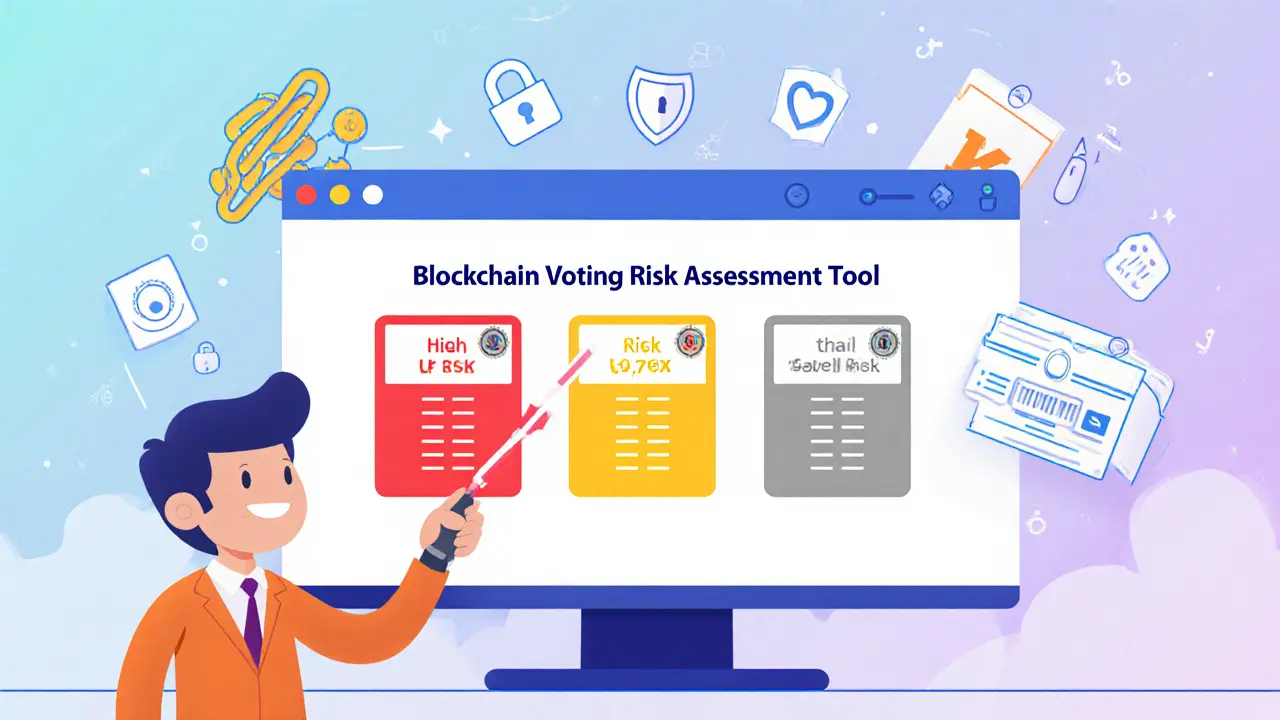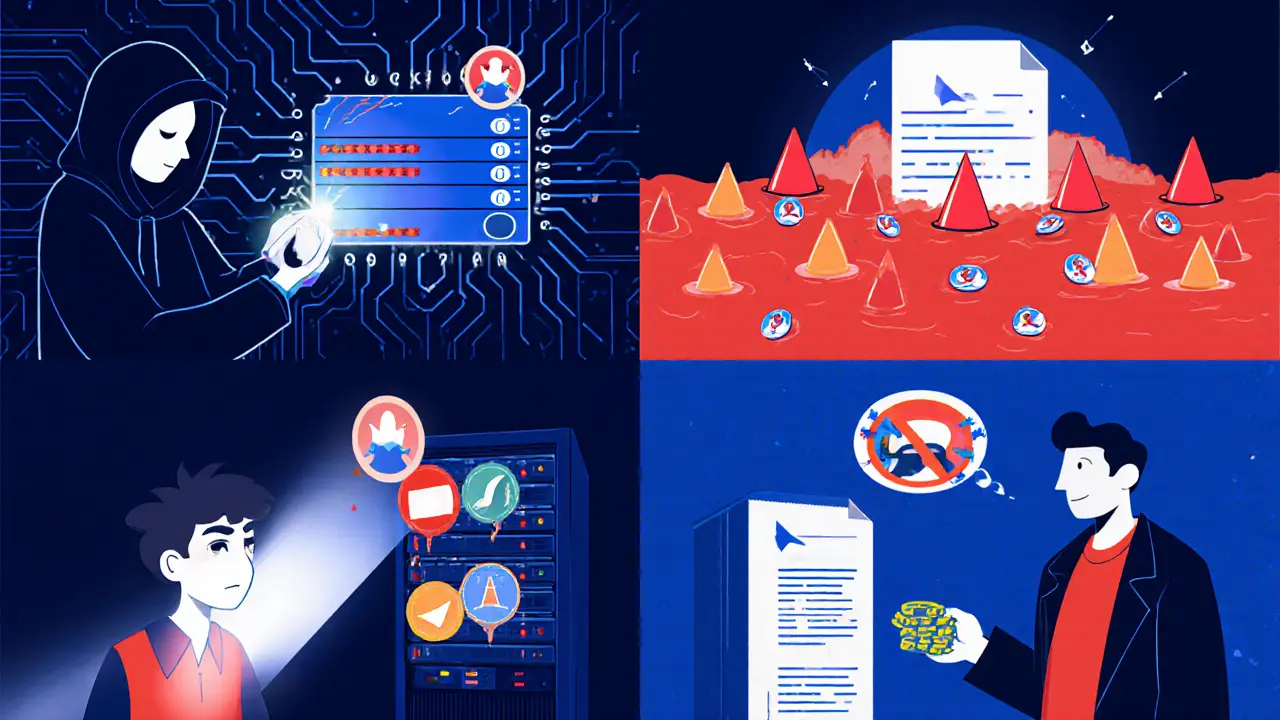Blockchain Voting Security Concerns: Risks, Reality, and the Road Ahead

Blockchain Voting Risk Assessment Tool
Silent Vote Alteration High Risk
Malicious code could rewrite votes before they reach the immutable ledger, leaving no trace.
Mass Disenfranchisement Medium Risk
Denial-of-service attacks on authentication nodes could block eligible voters.
Privacy Breach High Risk
Flaws in anonymity protocols may leak voting choices, enabling coercion.
Vote Selling Medium Risk
Cryptographic receipts could enable large-scale vote-selling schemes.
Risk Mitigation Recommendations
- Independent Security Audits: Demand third-party verification before deployment.
- Privacy Protocols: Implement zero-knowledge proofs and homomorphic encryption.
- Endpoint Hardening: Secure voter devices and authentication systems.
- Hybrid Models: Combine blockchain for result anchoring with traditional voting methods.
When people hear blockchain voting, they picture an unbreakable ledger that guarantees every ballot is safe. Blockchain voting is a electoral system that stores vote transactions on a distributed ledger, aiming to combine cryptographic security with public transparency. The promise is compelling, but the reality is riddled with technical and political pitfalls that could undermine the very democracy it hopes to protect.
Quick Take
- Four core attack vectors-silent vote alteration, mass disenfranchisement, privacy breaches, and vote‑selling-are considered virtually undetectable.
- Cryptographic safeguards (public‑key encryption, immutability, decentralization) help, but they don’t eliminate human‑error or implementation flaws.
- Pilot programs report high voter confidence, yet expert reviews warn of nation‑scale failure risks.
- International actors (state‑sponsored hackers, criminal groups) can exploit remote vulnerabilities.
- Limited uses like result timestamping on Bitcoin’s blockchain are gaining traction while full‑scale voting remains contentious.
How Blockchain Voting Supposedly Works
The architecture rests on three pillars:
- Cryptographic encryption uses public‑key pairs to ensure only authorized voters can cast a ballot while keeping the vote content secret.
- Immutability locks each vote into a block that cannot be altered without re‑writing the entire chain, providing a tamper‑evident record.
- Decentralization distributes ledger copies across many nodes, removing a single point of failure.
In theory, these features let anyone audit the election in real time, trace each ballot’s provenance, and run post‑election recounts without a trusted central authority.
What the Critics Say: Four Attack Vectors
The US Vote Foundation, a leading nonprofit watchdog, outlines the most dangerous scenarios. Their 2024 analysis highlights:
- Silent vote modification - malicious code could rewrite a vote before it hits the immutable layer, leaving no trace.
- Undetectable disenfranchisement - a coordinated denial‑of‑service attack on voter‑authentication nodes could block eligible voters from casting any ballot.
- Privacy violations - flaws in anonymity protocols might leak voting choices, enabling coercion or targeted harassment.
- Facilitated vote buying - cryptographic receipts could be used as proof of purchase, making large‑scale vote‑selling feasible.
All four are described as “virtually undetectable” and “irrevocable,” meaning any damage would persist after the election ends.
Academic Backing for the Risks
A 2020 paper in Oxford’s Journal of Cybersecurity concluded that internet‑ and blockchain‑based voting would "greatly increase the risk of undetectable, nation‑scale election failures." The paper cites three technical weaknesses: reliance on insecure client devices, the difficulty of guaranteeing true anonymity on a public ledger, and the challenge of securing the network layer against nation‑state actors. Josh Greenbaum, CTO of the US Vote Foundation, echoes the sentiment, calling blockchain voting "exceedingly risky and vulnerable to a host of dangerous cybersecurity attacks."
Who Might Exploit These Weaknesses?
Threat actors range from domestic partisans to sophisticated foreign intelligence services. The foundation notes that Russia, China, North Korea, and Iran have already meddled in U.S. elections and could target blockchain voting platforms with the same tools-malware, phishing, and supply‑chain attacks. A rogue node operator in a public network could also inject malformed transactions, subtly skewing results without raising alarms.

Real‑World Pilots: Confidence vs. Caution
Surveys tell a different story. A 2025 Gallup poll of blockchain‑voting participants shows 78% felt their ballot was securely counted, and 76% said the transparent ledger boosted trust. In a Georgia county pilot, Simple Proof’s timestamping system anchored election results on the Bitcoin blockchain, earning an 82% confidence rating among local officials. Yet these pilots rarely involve actual vote casting on the blockchain; they usually record results after paper ballots are tallied.
Companies like Voatz offers a mobile app that lets voters submit a cryptographically signed ballot to a blockchain network have run limited tests in U.S. overseas elections, but they have not been adopted for nationwide contests. Simple Proof provides a Bitcoin‑anchored timestamping service that secures election result data without handling voter‑level transactions is marketed as a safer, partial use of the technology.
European Implementations: A Different Regulatory Lens
European firms such as Polyas delivers end‑to‑end encrypted online voting platforms that comply with strict German election law and Luxoft builds customizable blockchain voting solutions for public and corporate elections, emphasizing smart‑contract based audit trails have secured contracts for university and corporate votes. Their approach often blends private permissioned blockchains with rigorous identity verification, sidestepping many of the public‑ledger privacy concerns flagged in U.S. research.
Comparison: Traditional E‑Voting vs. Blockchain Voting
| Feature | Traditional E‑Voting | Blockchain Voting |
|---|---|---|
| Data Storage | Centralized servers managed by election authority | Distributed ledger replicated across many nodes |
| Auditability | Limited to internal logs, often opaque to the public | Publicly visible transaction history (if permissionless) |
| Vulnerability to Single‑Point Failure | High - server outage can halt voting | Low - network resilience through decentralization |
| Privacy Guarantees | Depends on implementation; usually encrypted | Challenging - must balance transparency with anonymity |
| Scalability | Proven at national level | Still experimental; transaction throughput can be a bottleneck |
The table shows why many election officials remain hesitant: while blockchain solves some problems, it introduces new ones, especially around privacy and scalability.
Audit Opportunities and New Threats
The National Association of Secretaries of State’s 2025 white paper describes a “blockchain audit portal” that could match ballot IDs to blockchain entries, print a PDF of the marked ballot, and verify one‑to‑one correspondence. Such transparency could boost public trust, yet it also risks exposing metadata that, when combined with sophisticated traffic analysis, might de‑anonimize voters. Implementers must therefore embed zero‑knowledge proofs or homomorphic encryption-techniques that are still maturing.
Where Is the Market Headed?
Regulators are cautious. Wyoming has floated the idea of a “proof‑layer” for election results, but no state has approved full‑scale blockchain voting. Companies are pivoting toward hybrid models-using blockchain for result anchoring while keeping ballot casting on paper or legacy machines. This compromise acknowledges the technology’s audit benefits while sidestepping the most dangerous security gaps.
What Voters and Officials Can Do Today
- Demand independent security audits before any blockchain component is deployed.
- Insist on proven privacy primitives such as zero‑knowledge proofs, not just simple encryption.
- Validate pilot data against independent third‑party assessments rather than relying on vendor claims.
- Stay informed about threat actor activity-especially foreign interference campaigns that target election tech.
Until the core vulnerabilities are mitigated, blockchain voting should be treated as a promising supplement, not a replacement for established, auditable processes.

Frequently Asked Questions
Is blockchain voting completely tamper‑proof?
No. While the ledger itself is immutable, the endpoints-voter devices, authentication servers, and smart‑contract code-can be compromised, enabling silent vote manipulation.
Can a hacker change votes after they’re recorded?
Direct alteration of a block is practically impossible without rerunning the entire chain, but a compromised client can submit a forged transaction before it lands on the chain, making the change difficult to detect.
How does voter privacy work on a public ledger?
Privacy relies on cryptographic tricks like ring signatures or zero‑knowledge proofs that hide the link between a voter’s identity and the vote content while still proving legitimacy. Implementations that skip these safeguards expose votes.
Are any countries using blockchain voting for real elections?
Few. Some local trials in the U.S. (e.g., Georgia’s result timestamping) and corporate/university elections in Europe use permissioned blockchains. No national public election has fully adopted blockchain for ballot casting.
What’s the biggest advantage of using blockchain in elections?
The ability to create a tamper‑evident, publicly verifiable record that can be audited in real time, potentially increasing transparency and confidence when implemented correctly.
